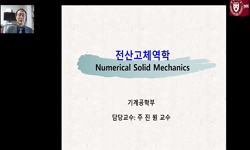The vibration test jig design should address the conflicting goals of improving natural frequency and reducing weight. Recently, an optimal design methodology has been proposed to achieve these objectives. This study investigated its applicability to ...
http://chineseinput.net/에서 pinyin(병음)방식으로 중국어를 변환할 수 있습니다.
변환된 중국어를 복사하여 사용하시면 됩니다.
- 中文 을 입력하시려면 zhongwen을 입력하시고 space를누르시면됩니다.
- 北京 을 입력하시려면 beijing을 입력하시고 space를 누르시면 됩니다.
https://www.riss.kr/link?id=A109679091
- 저자
- 발행기관
- 학술지명
- 권호사항
-
발행연도
2025
-
작성언어
Korean
- 주제어
-
KDC
505
-
등재정보
KCI등재
-
자료형태
학술저널
-
수록면
35-43(9쪽)
- 제공처
-
0
상세조회 -
0
다운로드
부가정보
다국어 초록 (Multilingual Abstract)
The vibration test jig design should address the conflicting goals of improving natural frequency and reducing weight. Recently, an optimal design methodology has been proposed to achieve these objectives. This study investigated its applicability to various headlamp models. Step-by-step optimization was conducted for four headlamp models, focusing on main ribs, reinforcing ribs, and holes. As a result, natural frequency improved in all models, with some achieving up to a 78.8 Hz increase and 16.6 kg weight reduction compared to the conventional design. The main and reinforcing ribs played a key role in enhancing natural frequency, with triangular rib structures identified as the most effective. Optimized hole design successfully contributed to weight reduction by eliminating unnecessary mass while maintaining the target frequency. To improve optimization efficiency, holes were designed with structures resembling rib shapes, reducing design variables. This study demonstrated the superior performance of the optimal design methodology over conventional empirical methods in achieving both natural frequency improvement and weight reduction. However, some limitations remain, including the lack of experimental validation and insufficient consideration of structural modes. Despite these limitations, this study establishes a foundation for applying optimal design beyond headlamp jig design, extending to other complex design challenges.
동일학술지(권/호) 다른 논문
-
- 한국산학기술학회
- 이승민(Seungmin Lee)
- 2025
- KCI등재
-
방사 차폐물로서의 유인우주기지 다층쉘 벽체 개발을 위한 기존 달표면 우주 방사 환경인자에 대한 조사와 기초 시뮬레이션
- 한국산학기술학회
- 장지훈(Jihoon Jang)
- 2025
- KCI등재
-
Controller Area Network에서 침입 탐지 시스템을 위한 센서 데이터를 예측하는 칼만 필터 기반의 공격 탐지 알고리즘 제안
- 한국산학기술학회
- 김정윤(Jeong-yun Kim)
- 2025
- KCI등재
-
사료 내 조단백질 및 Phytase 첨가 수준이 육계 후기의 생산성, 소화율 및 분뇨 내 질소, 인 함량에 미치는 영향
- 한국산학기술학회
- 홍의철(Eui-Chul Hong)
- 2025
- KCI등재





 DBpia
DBpia






